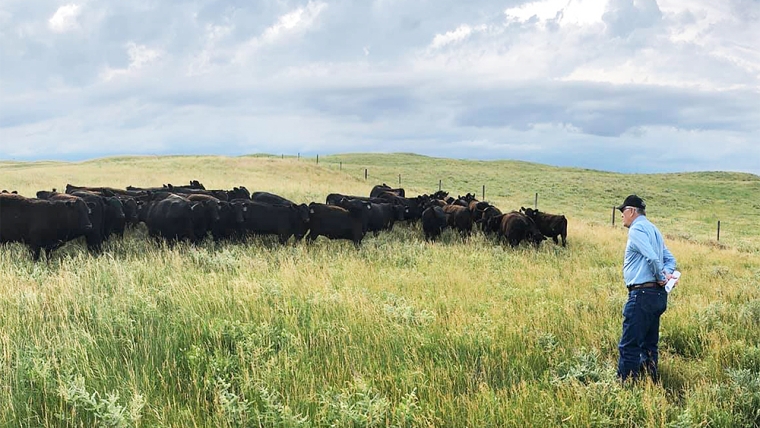
Shortening the distance between farm and fork has become something of a mantra in food policy circles, but in Nebraska a group of producers have taken it literally.
They have built their own beef plant, secured an offtake with the world’s biggest retailer, and set about designing a supply chain that pays farmers for quality the consumer can taste.
Listening to first-generation cattleman Trey Wasserburger describe the journey is a reminder that value capture is possible when producers decide to organise, invest and measure what matters. The lessons are not confined to the Sandhills. They speak to New Zealand’s red meat sector and, more broadly, to how our rural economy might hold on to more of the dollars it already earns.
Trey and his wife Dana run TD Angus at North Platte. “We sell about 500 Angus bulls a year,” he says, adding with a grin that it has been “a great year to be in the business.” His path in is instructive. “My dad’s a teacher, my mum’s a nurse… I kind of took my own path,” he explains. For all the talk that you must be born into agriculture, he disagrees. “There’s so much opportunity out there today… if they want to do the hard things.” He reels off examples, from building fence to breeding and calving heifers. Labour is young on his place. “Our average labour is about 27 years old.” When he tries to hire fencers, he jokes, “I’ll take whatever I could find… name your price.” Anyone who has tried to staff a New Zealand farm or contracting outfit in the last few seasons will recognise the same pressure.
The plant story began in 2020 when processing slots were scarce and tempers short. “A bunch of like-minded producer type gentlemen… decided to build a packing plant,” Trey says. It took political stamina and commercial nous. North Platte backed the project. Industry veterans joined the board and management. Then came the distribution piece. “We had the largest retailer in the world come to us and say, ‘We believe in what you guys are doing… we’d like to buy your product,’ and that was Walmart.”
Construction followed and ramp-up began this year. “We’re probably in that seven, eight hundred head a day range,” he says, targeting 1,500 head at steady state. The ambition is not to mimic the global majors. “Do I want to be at 6,500 head a day? The answer is no… those guys are really, really good at it.” His respect for the operational grind is clear. “Every day is a jigsaw… three, four hundred people in there with a moving chain all being cohesive together.”
What makes the model interesting for New Zealand is not the logo on the supermarket door but the alignment from genetics to shelf. “We don’t need just more beef. We need better,” Trey says. Better, in his view means a rib-eye that fits the plate, high tenderness and consistent grading. They collect DNA at a day old, select for eating quality and manage for uniform carcase weights so cutting is easier and retail presentation cleaner. If something is not selling, they trace it back and adjust. “There’s accountability in this entire supply chain, and we’re all trying to pull the wagon in the same direction.”
There are obvious parallels here. Our exporters already sell premium to demanding markets, but too often the price signals that matter to a family at the barbecue in Auckland or Singapore fade by the time they reach the farm gate. Trey’s message is that design matters. His plant leaves as boxed beef cut to specific retailer-tested specs because that is what the data says customers buy. “It’s listening to your consumer,” he says simply. The principle is portable. Could producer-backed programmes here test and lock in retail-proven eating-quality specs, then reward the farms that deliver them week in, week out? Could they do it in sheep meat as well as beef and link it to genetics, pasture management and animal health records that farmers already keep?
Traceability is the next obvious step. Consumers say they want it, but Trey is pragmatic about who pays. “It’s kind of hard to say the consumer will pay for that today… it’s been untested.” What he does see is appetite for provenance storytelling that is real, not glossy. Buyers want to “see the baby calves on green grass… the kid over there feeding his pig.” Again, familiar ground. Our landscape advantage is not just scenery; it is a trust asset. Used well, it can support premium programmes that return dollars to farms, not just clicks to brand managers.
There is another seam in Trey’s story that resonates here: generational transition. He is living proof that non-family entrants can thrive if someone opens the gate. “There is a path to it,” he says. “If both sides give a little bit, you can make it happen.” In New Zealand, where succession is often a mix of emotion and hard numbers, this is more than a motivational quote. It is a labour market strategy. If we want skilled young people to choose agriculture, we must make room for equity pathways, sharefarming models and genuine partnerships that reward effort and learning. Trey’s advice to newcomers is blunt. “Do the things that no one else wants to do, and you’ll always make a living.” The corollary for owners is to back those people with training, responsibility and a stake.
Markets, meanwhile, remain buoyant. Trey does not see a rush to retain heifers. “Why would you breed one,” he asks, when yearling heifers are fetching such money. He worries about who will calve them. “Breeding them is hard. Calving them is harder.” It is a reminder that herd rebuilding cycles are human as much as economic. Here too, our decisions in the next year or two will echo. If confidence holds and processing capacity remains steady, the opportunity is to grow value per head rather than simply chase numbers. That takes discipline and clarity about what the customer will pay for.
What might a New Zealand version of Trey’s playbook look like? It does not have to be a new greenfield plant. It could be a producer-owned programme inside existing capacity, contracted to deliver specified eating-quality and package formats to a retail partner that will share data and reward consistency. It could be regional, close to finishing country and labour. Governance must be professional. Measurement is non-negotiable. “How do we improve if we’re not measuring,” Trey asks. Genetics companies, vets, processors and retailers would have to agree on targets that make sense to shoppers. Then stand behind them for long enough to matter.
The bigger point is cultural. Trey calls his group “a couple cowboys that wouldn’t quit.” New Zealand has plenty of that grit. We also have world-class pasture systems, a logistics network that can move chilled product fast and retailers who want reliable, differentiated supply. The missing pieces are often alignment and feedback. When farmers can see and share in the value their animals create at the end of the chain, behaviour changes at the start. That is how you shorten the distance from farm to fork without slogans.
Trey is clear-eyed about partners that polarise. Some producers tell him they will not buy steaks from the retailer he sells to. He shrugs. “It’s the largest retailer… If you’re selling any kind of beef, you’re in business with them.” The translation for us is to work with scale where it helps and keep producer control where it counts. “We’re very much different,” he says. “We’re producer owned.” That is the line to hold.
In the end, this is a story about taking responsibility for your own value chain. Measure what matters. Design for the customer. Share data back to the farm. Create on-ramps for young people who will do the hard jobs and learn fast. And when everyone is pulling the wagon in the same direction, do not be surprised when more of the retail dollar ends up where it belongs. As Trey puts it, “We don’t need just more beef. We need better.” New Zealand knows how to do better. The question is whether we will organise to prove it and get paid.
Have a listen to the podcast to hear the full story.
Angus Kebbell is the Producer at Tailwind Media. You can contact him here.
1 Comments
I'm struggling to decide how to open this comment. Your article has spurred thoughts on loyalty, technology uptake, messaging, farm profitability, supermarkets as the gate keepers to consumers, ....
Farmer owned cooperative came to mind as i read the article. Either they can be small to carve a niche in a very large domestic market like the US, or large with compulsory acquisition to compete in the massive global market, like Fonterra, Zespri, holding the scale to drive the quality improvement push/pull between consumer and farmer. But a cooperative can't be small when the NZ farm production focus is to supply the massive global market.
I understand the bull beef production system in NZ. It's production end point is lean grinding beef for the burger market. But a grinding lamb meat market doesn't really exist. I often wonder what the eating quality of 6+ month old cryporchid lamb is. They are effectively entire males, with similar growth characteristics to bulls - more lean muscle. From a farm production perspective it makes sense - higher yield of total carcass kg/ha and $/ha are achieved. But NZ lamb is targeted at the premium eating quality end of the market, not manufacturing. What are the implications of this for NZ prime lamb reputation?
There are on farm quality assurance programs in NZ, ostensibly to provide consumer assurance of quality. But when a significant portion of that lamb is cryptorchid, I become suspicious of the integrity of the QA programs. They look to be more about procurement security. After all each processor has their own bespoke program that is not recognised by other processors. When farms operate on slim profitability margins, a few cents per kg difference in what is offered, typically trumps loyalty.
The individual components to create a closer link between farm and fork already exist in NZ. IMO there is too much vested interest and fragmentation at the processor and exporter end of the sector, to enable the NZ red meat sector to realise the potential of bringing all those components together into a universal NZ red meat QA program.

We welcome your comments below. If you are not already registered, please register to comment
Remember we welcome robust, respectful and insightful debate. We don't welcome abusive or defamatory comments and will de-register those repeatedly making such comments. Our current comment policy is here.